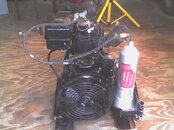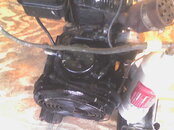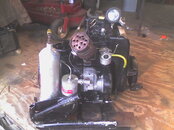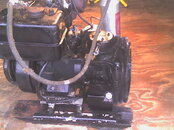rjack, I have been pondering much the same thing, why it works. It only makes sense if one understands the nature of 13X dessicant. Yes, it is temperature sensitive, and cooling the input air helps; sometimes, a lot. However, it does not explain everything. To me, it seems reasonable to assume that the 13X would behave inside a filter the way it does in the atmosphere, eg, there would be higher uptake of water in the humid environent inside a cartridge caused when air is compressed. That is what my calcs are based on.
Imagine two traffic tunnels. In one of the tunnels the traffic is moving very fast and the cars are widely spaced. Inside the other, the speedy traffic suddenly slows in the tunnel and the cars are spaced very closely together. At the outlet of each tunnel, the total number of cars emerging per minute is the same. Yes, the cars in the slow tunnel are emerging at a slower speed but they are much closer together, the space between them is "compressed". This is a picture of dwell, the extra time spent in the tunnel is defined as "dwell" time.
If we think of 13X as a "sponge", it would be reasonable to observe higher uptake of water in a humid environment, and lower uptake when the surrounding air is dry. This is what happens when one spreads some dessicant on a sheet inside a box of air. The dessicant seems to be "soaking" up the water.
However, with an ad-sorber like 13X,the ability to capture water vapor is based entirely on the number of collisions of water molecules with the particles of 13X. Air with no apparent movement is actually speeding along at a molecular level which which science calls calls "Brownian" movement. Over short distances, the molecules are travelling very fast indeed. They constantly impact hard surfaces nearby. By definition, there is a dense concentration of water molecules in air with high humidity and low concentration in low humidity. When the air is still with no apparent movement, this variance, in Brownian physics, directly influences the number of collisions and the amount of water vapor trapped by the dessicant. Since the dessicant has higher uptake in wet humid air it appears to be acting like a sponge. The dessicant is not acting like a sponge no matter what the tests may suggest, the dessicant is not absorbing but ad-sorbing and is trapping more molecules because in higher humidity there is greater statistical likelihood of collisions.
Imagine that the two tunnels have potholes, the same number, general size and spacing. It is statistically true that the two traffic streams, one slow and one fast, will impact the same number of potholes over a period of time. This is because the same number of cars are striking potholes provided the spacing of the vehicles or the speed inside the tunnel are such that the identical number of vehicles are exiting over a period of time.
This little metaphor illustrates why 13X behaves seemingly differently on the sheet of paper than expected for an adsorber but is actually obeying the laws of physics. Since nothing is apparently moving there should be no pothole problems. Yet, it is all about collisions with potholes. Inside a filter, the air is definitely not still, it is moving carrying the water vapor right along with it. Thus, Brownian movement and humidity are no longer controlling factors for adsorption. Although they are still around, they are no longer important for purposes of analysis. The collision rate begins to resemble the situation inside the tunnels. Inside the filter, regardless of whether the air is entrained inside the slow tunnel (dwell), or allowed to whiz through the fast tunnel (no backpressure, no dwell) the number of collisions with "potholes" are the same. Since the air in the filter, dwell or not, is actually moving, the number of collisions are no longer influenced by humidity (dense traffic) as was seen when spread on the sheet. Under forced motion, the same number of molecules will impact the "holes" in 13X no matter what. If the molecular collision strikes one of the billions of 10 angstrom "potholes" in this dessicant, the water is trapped. Whether the air stream is fast and loose or slow and dense, in the end, the collisions and the uptake of moisture are the same.







